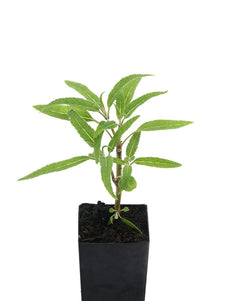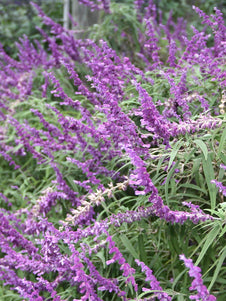









Salvia leucantha 'Mexican Sage'
Salvia leucantha 'Mexican Sage'

- Low stock - 6 items left
- Inventory on the way

Usually available: All year
Life cycle: Perennial
Height: 1 - 1.5m
Position: Full sun
Soil preference: Well drained
This is how we pack and send your Herb Plants to all states except TAS & WA
You will receive
- 1 Salvia Mexican Sage Herb Plant in a 50 X 75mm tube - General growing instructions
All of our Herb Plants are grown organically with certified organic potting mixes and fertilizers
Botanical Name: Salvia luecantha
Mexican Sage is a hardy, old fashioned sage, which has been a garden favourite for many years. It is sometimes also called ‘woolly sage’, due to the slight white ‘woolly’ features of the new growth stems and underside of the leaves. It can grow from 80cm to 1.2 meters tall and equally as wide and has many erect stems that arch at the tips when in flower. This sage has linear, lanceolate, grey-green leaves which provide a nice contrast to other garden plants all year round.
The original form of this salvia has velvety purple flowers and dark purple calyces. There is often a hazy, slightly white patch visible as well. The fuzzy dark purple calyces stay on the plant long after the flower petals have gone, providing a nice colourful display. The peak bloom period is spring to autumn, but in the right climate they can flower all year round. This old favourite is also known for the graceful arching branches that result when the floral display appears.
Mexican Sage blooms late in the season, so it provides butterflies with a source of nectar when other flowers are scarce. There are several varieties with different features, including Santa Barbara and Midnight.
Growing Conditions
Mexican sage is one of the fastest growing salvias, with a hardy disposition. The native habitat is warm and similar to temperate Australia, so dry conditions suit this salvia. It is drought tolerant, preferring a deep watering once a week when hot. However, hot and moist or wet conditions like the tropics do not suit this salvia. Most soil conditions are suitable, but enrichment with organics matter will be helpful. Only light shade is tolerated and the plant will get too leggy and scraggly, as it tries to reach for the sunlight.
In colder areas the growing season may be quite short, as will the flower show. Once the cold weather arrives growth will slow, as will the flowering and the plant may die down completely in deep frosts. Mild frosts should be tolerated by established plants, but young plants may need protection for the first few years. In the areas where it is too cold for Mexican Sage to perform well, it will do nicely as a container plant or may be bought inside if necessary.
In the right climate, Mexican Sage flowers almost all year. The flowering season is late compared to other salvias and extends from spring and mid to late summer all the way through to autumn and even into warm winters. The arching stems may break when the top heavy flowers display is in full swing, so a light prune may be required.
Propagation is by cuttings or dividing the mound into several clumps. It is not considered to be an invasive plant, but Mexican Sage does tend to creep along as it grows. Every 2-4 years you may like to dig some of the plant out, if it has spread a little too far, or put a ground level barrier in place to restrict growth. General pruning will help to promote bushiness and it may be cut to ground level late in the season, when new growth starts to appear at the base.
When grown with rosemary and lavender the garden takes on a Mediterranean look. It is one of the few sages suitable for use as a cut flower, because the fuzzy purple calyces stay on the plant long after the petals fall. This means it can also be used for everlasting arrangements, because the colour is also retained.
The salvia family has over 900 members with an extensive history as culinary, medicinal and ornamental plants. Ornamental salvias have become collectors’ items, as gardeners try to find a place in their garden for each and every one. There are salvias that will suit every type of soil and climate. More information on the Salvia genus and Common Sage (Salvia officinalis) may be found on our Common Sage page.
Culinary Uses
Mexican sage is not usually considered to be a culinary sage, but further information on culinary uses for sage plants may be found on the Common Sage Herb page.
Medicinal Uses
Sage has a wide variety of medicinal uses and Mexican sage may have been used for this purpose where it grows locally. S. leucantha has been found to contain specific sesquiterpene hydrocarbons and other compounds. Please see Common Sage for additional information.
All information provided on this website is for informational purposes only. Please seek professional advice before commencing any treatment.





